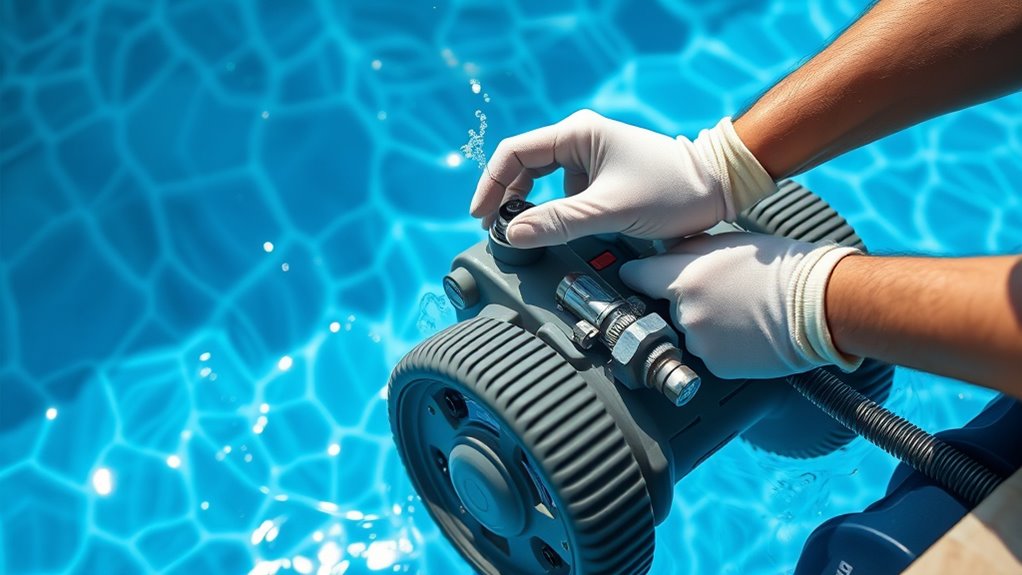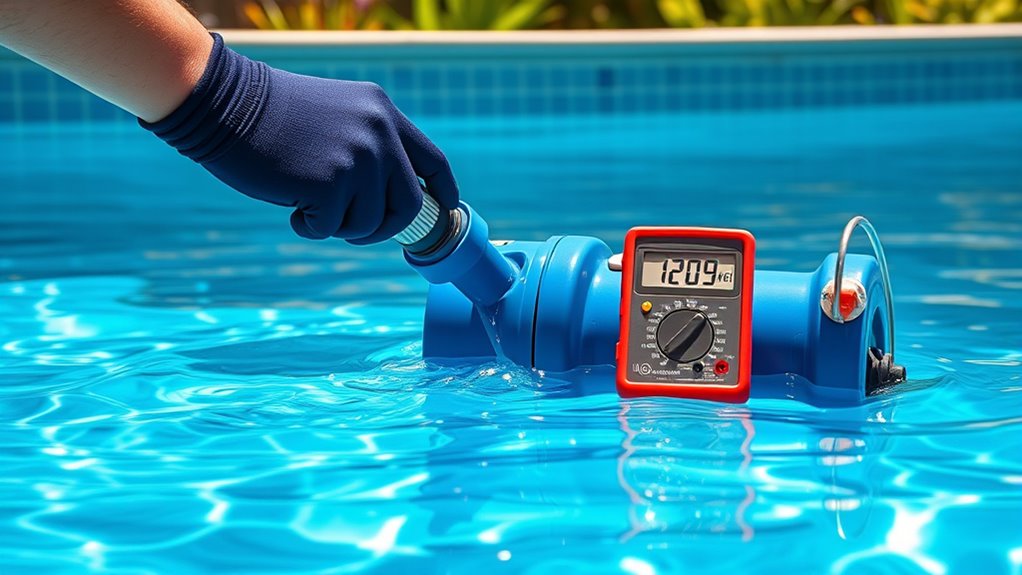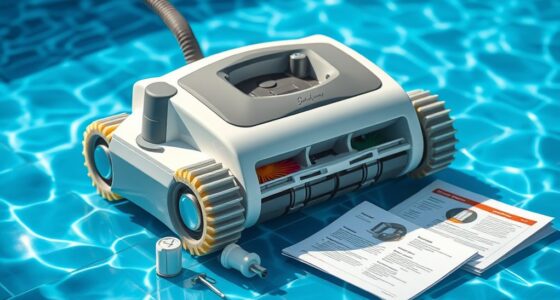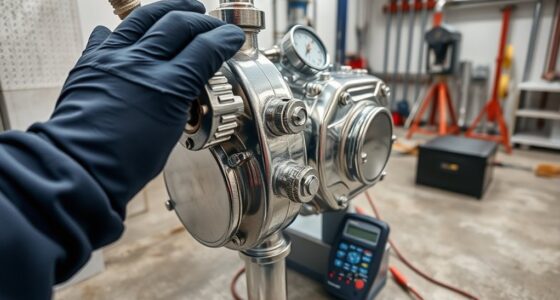To troubleshoot your pressure pool cleaner, start by inspecting the pump, filters, and impeller for clogs or damage, as these restrict water flow and reduce pressure. Check the strainer basket for debris and make sure hoses are free of leaks, cracks, or kinks. Confirm water circulation is adequate and all fittings are tight. Regular maintenance of these components can improve performance. Stay tuned to discover more tips to get your cleaner running smoothly.
Key Takeaways
- Check and clean filters and impellers regularly to ensure optimal water flow and pressure.
- Inspect hoses for leaks, cracks, or kinks, and replace or straighten as needed to maintain proper water flow.
- Ensure the strainer basket is clear of debris to prevent flow restrictions and pressure drops.
- Verify water levels are adequate and that the pump is operating at full capacity for effective cleaning.
- Confirm all fittings are tight, and remove any obstructions in the system to optimize pressure and performance.

A pressure pool cleaner is an effective way to keep your pool spotless, but when it stops working properly, it can be frustrating. One common issue is the cleaner not moving correctly or losing suction. To troubleshoot effectively, start by checking your pump maintenance. The pump is the core of your pressure cleaner, providing the necessary force to propel the cleaner around the pool. If your pump isn’t operating at full capacity—perhaps due to clogged filters, worn-out impellers, or low water levels—the cleaner won’t function properly. Make sure to clean or replace your filters regularly, as dirty filters restrict water flow and diminish pump performance. Also, inspect the pump’s impeller for debris or damage, since a malfunctioning impeller can reduce pressure and hinder cleaning. Confirm that your pump’s strainer basket isn’t clogged, as this can also restrict flow. Maintaining your pump is essential because even small issues can considerably impact the cleaner’s effectiveness. Regular pump maintenance ensures optimal performance and prolongs equipment life. Additionally, ensuring that your pressure system is set up correctly can help maintain consistent cleaning performance.
Next, focus on hose inspection. The hose connects your pressure pump to the cleaner, and any leaks or blockages can disrupt pressure and movement. Carefully examine the entire length of the hose for cracks, holes, or loose fittings. Leaks decrease the pressure reaching the cleaner, making it sluggish or immobile. Tighten any loose fittings, and replace damaged sections of hose promptly. While inspecting, also check for kinks or twists, which can restrict water flow. Straighten out any bends, and ensure the hose is free of obstructions. Proper hose maintenance helps maintain ideal pressure and ensures the cleaner moves smoothly around the pool. Sometimes, debris or algae can get stuck inside the hose, so flushing it with water or replacing it altogether can restore proper function. Additionally, ensuring your system has adequate water circulation can improve overall pressure and cleaner performance. For optimal operation, it’s also important to verify that your pool’s filtration system is functioning correctly, as it directly impacts water flow and pressure levels. Properly functioning pool equipment is vital for maintaining consistent pressure and efficient cleaning.
Frequently Asked Questions
Can I Use a Pressure Pool Cleaner on an Above-Ground Pool?
You can use a pressure pool cleaner on an above-ground pool, but you need to check for above ground compatibility first. Make sure the cleaner’s pressure requirements match your pool’s pump capacity to guarantee peak performance. Some models are designed specifically for above-ground pools, while others may require adapters or modifications. Always verify the cleaner’s specifications and your pool’s setup to ensure effective cleaning without damaging your equipment.
How Often Should I Replace the Cleaner’S Parts?
Your pressure pool cleaner’s parts wear out faster than a speeding bullet, so regular maintenance is essential. You should replace parts as needed based on their condition, but a good rule of thumb is every 1 to 2 seasons. Stick to a consistent maintenance schedule, inspecting hoses, brushes, and filters frequently. Proper part replacement keeps your cleaner running smoothly and extends its lifespan, saving you money in the long run.
Is It Safe to Leave the Cleaner in the Pool Overnight?
You might wonder if it’s safe to leave your pool cleaner in overnight. Generally, it’s okay, but consider pool chemicals and debris removal. Leaving it in won’t harm the cleaner, but it could affect water chemistry or cause debris buildup. Make sure to check your cleaner regularly, remove debris, and monitor chemical levels. Removing the cleaner after use can help make sure your pool stays balanced and clean, especially overnight.
What Is the Ideal Water Temperature for Optimal Cleaning?
The ideal water temperature for maximum cleaning is between 78°F and 82°F. When the water stays within this range, your pool cleaner works more efficiently, removing debris and dirt effectively. Cooler water can slow down the cleaning process, while warmer water might cause the cleaner to work too quickly and miss spots. Keep your pool within this temperature range to guarantee the best cleaning efficiency and maintain a sparkling, inviting pool.
How Do I Prevent the Cleaner From Getting Stuck on Pool Obstacles?
To prevent your cleaner from getting stuck on pool obstacles, focus on obstacle navigation, obstacle clearance, and obstacle awareness. Regularly inspect and remove debris or sharp edges that could cause cleaner obstructions. Adjust the cleaner’s path by repositioning or removing obstacles when possible. Use the cleaner’s settings or features designed for better obstacle navigation. With proactive obstacle management, you’ll keep your pool cleaner moving smoothly and maintain a spotless pool effortlessly.
Conclusion
Now that you’ve gone through the troubleshooting steps, you’re better equipped to keep your pressure pool cleaner running smoothly. Remember, sometimes it’s just a small tweak that makes all the difference. Don’t let little hiccups turn into bigger headaches—nip problems in the bud before they escalate. With a bit of patience and the right know-how, you’ll have your cleaner gliding effortlessly in no time. Keep at it, and you’ll have a sparkling pool without breaking a sweat.










